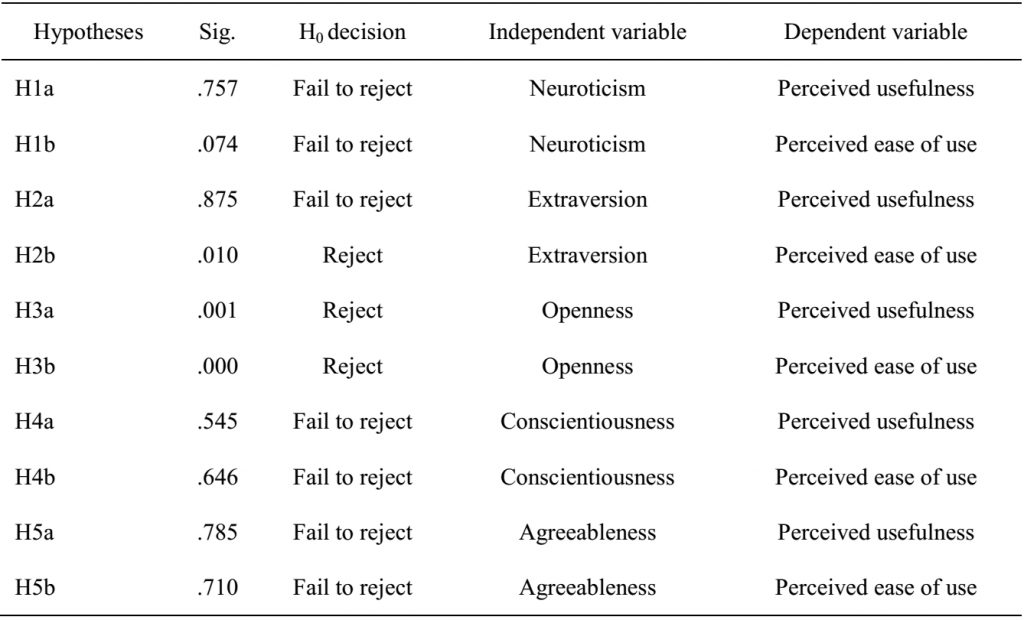
Personality & technical knowledge management systems research: Results [Personality & TKMS series]
This is part 19 of a series of articles featuring edited portions of Dr. Maureen Sullivan’s PhD dissertation.
As discussed in the previous article, data for the study was collected through an online survey, and then entered into a statistical package for analysis and reporting.
Participant demographics
The survey included demographic data questions. These questions were derived from other studies, and were included with a view to potentially using the gathered data for future studies looking at how the results relate to demographics1.
The number of subjects who participated in the study was 251. Approximately half (118; 56.7%) of the participants were between the ages of 30 and 49. One hundred and twelve (54.1%) of the participants identified themselves as being female and 95 (45.9%) male. A majority of the participants were either White/European American (117; 57.1%) or Black/African American (62; 30.2%). The respondents‘ education was reported as follows: two had (1.0%) some high school education, one (0.5%) had a high school diploma, seven (3.3%) had some college education, two (1.0%) had associate‘s degree, 44 (21.1%) had a bachelor‘s degree, and 153 (73.2%) completed postgraduate work.
Hypothesis testing
Linear regression was performed to address each null hypothesis using the testing procedures defined by Howell2 and Stevens3. First, the participants’ data were screened for outliers. The participants‘ residuals were standardized, and the resulting z-scores were utilized to identify outliers in the data. A participant was considered an outlier when the standardized residual was greater than 3. The next step was to assess model linearity and homoscedasticity using a plot of standardized residuals. Finally, the regression coefficients statistics were calculated to determine if the variable was a significant predictor of perceived usefulness and perceived ease of use.
Research question 1
The first research question was: Among users of technical knowledge management systems (TKMSs), does neuroticism (personality type) as measured by the five-factor model (FFM), correlate to the acceptance of TKMSs as measured by the technology acceptance model (TAM)? Two sets of hypotheses were used with this research question. The first set of hypotheses was:
- H1a0: Measures of the personality type neuroticism do not have a positive linear relationship to the perceived usefulness of TKMSs as measured by the TAM.
- H1aA: Measures of the personality type neuroticism have a positive linear relationship with the perceived usefulness of TKMSs as measured by the TAM.
A significance of .757 indicated a failure to reject Hypothesis H1a0 in research question 1. Therefore, this study did not show that the personality type neuroticism has a positive linear relationship with the perceived usefulness of TKMSs as measured by the TAM.
The second set of hypotheses was:
- H1b0: Measures of the personality type neuroticism do not have a positive linear relationship to the perceived ease of use of TKMSs as measured by the TAM.
- H1bA: Measures of the personality type neuroticism have a positive linear relationship to the perceived ease of use of TKMSs as measured by the TAM.
A significance of .074 indicated a failure to reject Hypothesis H1b0 in research question 1. Therefore, this study did not show that the personality type neuroticism has a positive linear relationship with the perceived ease of use of TKMSs as measured by the TAM.
Research question 2
The second research question was: Is there a relationship between the extraversion personality type and the acceptance of TKMSs? Two sets of hypotheses were used with this research question. The first set of hypotheses was:
- H2a0: Measures of the personality type extraversion do not have a positive linear relationship with the perceived usefulness of TKMSs as measured by the TAM.
- H2aA: Measures of the personality type extraversion have a positive linear relationship with the perceived usefulness of TKMSs as measured by the TAM.
A significance of .875 indicated a failure to reject Hypothesis H2a0 in research question 2. Therefore, this study did not show that the personality type extraversion has a positive linear relationship with the perceived usefulness of TKMSs as measured by the TAM.
The second set of hypotheses was:
- H2b0: Measures of personality type extraversion do not have a positive linear relationship with the perceived ease of use of TKMSs as measured by the TAM.
- H2bA: Measures of personality type extraversion have a positive linear relationship with the perceived ease of use of TKMSs as measured by the TAM.
A significance of .010 indicated a rejection of H2b0 in research question 2. Therefore, this study showed that the personality type extraversion has a positive linear relationship with the perceived ease of use of TKMSs as measured by the TAM.
Research question 3
The third research question was: Is there a relationship between the openness personality type and the acceptance of TKMS? Two sets of hypotheses were used with this research question. The first set of hypotheses was:
- H3a0: Measures of personality type openness do not have a positive linear relationship with the perceived usefulness of TKMSs as measured by the TAM.
- H3aA: Measures of personality type openness have a positive linear relationship with the perceived usefulness of TKMSs as measured by the TAM.
A significance of .001 indicated a rejection of Hypothesis H3a0 in research question 3. Therefore, this study showed that the personality type openness has a positive linear relationship with the perceived usefulness of TKMSs as measured by the TAM.
The second set of hypotheses was:
- H3b0: Measures of personality type openness do not have a positive linear relationship with the perceived ease of use of TKMSs as measured by the TAM.
- H3bA: Measures of personality type openness have a positive linear relationship with the perceived ease of use of TKMSs as measured by the TAM.
A significance of .000 indicated a rejection of Hypothesis H3b0 in research question 3. Therefore, this study showed that the personality type openness has a positive linear relationship with the perceived ease of use of TKMSs as measured by the TAM.
Research question 4
The fourth research question was: Is there a relationship between the conscientiousness personality type and the acceptance of TKMSs? Two sets of hypotheses were used with this research question. The first set of hypotheses was:
- H4a0: Measures of personality type conscientiousness do not have a positive linear relationship with the perceived usefulness of TKMSs as measured by the TAM.
- H4aA: Measures of personality type conscientiousness have a positive linear relationship with the perceived usefulness of TKMSs as measured by the TAM.
A significance of .545 indicated a failure to reject Hypothesis H4a0 in research question 4. Therefore, this study did not show that the personality type conscientiousness has a positive linear relationship with the perceived usefulness of TKMSs as measured by the TAM.
The second set of hypotheses was:
- H4b0: Measures of personality type conscientiousness do not have a positive linear relationship with the perceived ease of use of TKMSs as measured by the TAM.
- H4bA: Measures of personality type conscientiousness have a positive linear relationship with the perceived ease of use of TKMSs as measured by the TAM.
A significance of .646 indicated a failure to reject Hypothesis H4b0 in research question 4. Therefore, this study did not show that the personality type conscientiousness has a positive linear relationship with the perceived ease of use of TKMSs as measured by the TAM.
Research question 5
The fifth research question was: Is there a relationship between the agreeableness personality type and the acceptance of TKMSs? Two sets of hypotheses were used with this research question. The first set of hypotheses was:
- H5a0: Measures of personality type agreeableness do not have a positive linear relationship with the perceived usefulness of TKMSs as measured by the TAM.
- H5aA: Measures of personality type agreeableness have a positive linear relationship with the perceived usefulness of TKMSs as measured by the TAM.
A significance of .785 indicated a failure to reject Hypothesis H5a0 in research question 5. Therefore, this study did not show that the personality type agreeableness has a positive linear relationship with the perceived usefulness of TKMSs as measured by the TAM.
The second set of hypotheses was:
- H5b0: Measures of personality type agreeableness do not have a positive linear relationship with the perceived usefulness of TKMSs as measured by the TAM.
- H5bA: Measures of personality type agreeableness have a positive linear relationship with the perceived ease of use of TKMSs as measured by the TAM.
A significance of .710 indicated a failure to reject Hypothesis H5b0in research question 5. Therefore, this study did not show that the personality type agreeableness has a positive linear relationship with the perceived ease of use of TKMSs as measured by the TAM.
Hypothesis testing summary
Table 1 presents the hypothesis testing decisions for each research question. Null Hypotheses 2b, 3a, and 3b were rejected. The research failed to reject the remaining null hypotheses.

The results of this study indicate that the specific personality types of openness and extraversion positively affect the acceptance of TKMSs as they relate to perceived ease of use and perceived usefulness. More specifically, the personality type extraversion proved to have a positive linear relationship with the perceived ease of use of TKMSs as measured by the TAM. Also, the personality type openness proved to have a positive linear relationship with the perceived usefulness and perceived ease of use of TKMSs as measured by the TAM.
Other studies of personality type/traits and the correlation of the TAM resulted in similar results. For instance, Wang and Yang‘s4 study of the role of personality traits in the UTAUT model in online stock investment participation resulted in the extraversion and openness personality traits significantly affecting the intent to participate in online stock investment. These results are similar to this study in that the extraversion and openness personality traits also significantly affect the perceived usefulness and perceived ease of use of TKMSs.
Next edition: Personality & technical knowledge management systems research: Implications for practitioners.
References:
- Udoh, E. E. (2010). The adoption of grid computing technology by organizations: A quantitative study using technology acceptance model (Doctoral Dissertation). Available from ProQuest Dissertations and Theses database. (UMI No. 3397359) ↩
- Howell, D.C. (2011). Fundamental Statistics for the Behavioral Sciences (7th ed.). Belmont, CA: Wadsworth Cengage Learning. ↩
- Stevens, J. P. (2002). Applied multivariate statistics for the social sciences (4th ed.). Mahwah, NJ: Erlbaum. ↩
- Wang, H. I., & Yang, H. L. (2005). The role of personality traits in UTAUT model under online stocking. Contemporary Management Research, 1(1), 69-82. ↩






